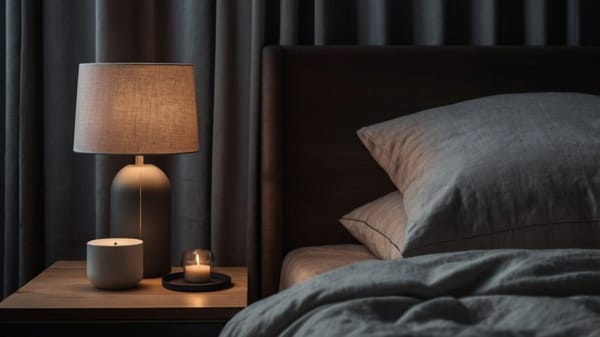The Power of Sleep Rituals and Repetition
Discover how simple, consistent sleep rituals can help you fall asleep faster, wake up clearer, and feel better—night after night.

What if the secret to deeper, easier sleep wasn’t in your mattress—or your phone—but in your habits? Your brain doesn’t want new tricks. It wants signals.
Clear, steady ones. When you repeat the same simple actions before bed, your body starts to anticipate sleep instead of resisting it. That’s the power of ritual.
No gimmicks, just rhythm. Start small, stay consistent, and you can shift how you sleep—and how you feel all day.
Repetition Is Your Brain’s Native Language
Your brain isn’t wired to respond to random inputs. It’s built for patterns. This is especially true when it comes to sleep.
Internally, you’re running on circadian rhythms—24-hour biological clocks that regulate everything from melatonin production to body temperature to mood.
These rhythms get stronger when your behaviors align with them. Go to sleep at different times every night, and your body loses the signal. Give it a predictable pre-sleep routine, and it learns.
Quickly. That’s how Olympic athletes, elite military units, and high-performers lock in deep recovery—by building rituals, not just routines.
Science backs this up. Studies from sleep researchers at Harvard and the University of Pennsylvania show that people with consistent wind-down behaviors not only fall asleep faster but experience higher sleep efficiency—meaning they spend more of their time in bed actually asleep, not tossing and turning.
Consistency isn't about being rigid. It’s about giving your brain less to negotiate with. When your body knows what’s next, it cooperates. You don’t force sleep. You prepare for it.

Sleep Rituals: More Than Just Relaxation
A good sleep ritual isn’t about what sounds relaxing. It’s about what teaches your brain to shift states. Every action before bed can either reinforce sleep onset—or delay it.
Let’s say you finish a workout late, eat dinner at 9, scroll through TikTok for an hour, then finally try to wind down at 11:30 by watching “just one” episode. Your brain never gets the signal. Sleep becomes a battle.
Now flip it. You dim your lights at 9. You make a calming tea, read 10 pages of fiction under a warm bulb, and do a breathing pattern you’ve been practicing. It’s not flashy, but it’s familiar. That’s what matters.
The power of repetition lies in association. When the same behaviors happen in the same order, your nervous system connects them to sleep.
Over time, the moment you light that candle or start that breathwork, your body gets ahead of you. It starts shutting things down before you even hit the bed.
The Science Behind Ritual Cues
Let’s break down how these rituals actually work on a physiological level:
- Dim lighting triggers your brain to increase melatonin production. Bright, overhead lights suppress this process. That’s why even 30 minutes of low light can shift your body into “night mode.”
- Thermal cues, like a warm shower or bath, prompt a post-bath drop in core temperature—another strong signal that sleep is coming.
- Smell connects directly to the brain’s emotional center. Scents like lavender, cedarwood, and chamomile can engage your parasympathetic nervous system, reducing heart rate and preparing the body to rest.
- Auditory cues like calming music or white noise train your brain to associate specific sounds with quieting down—just like a lullaby, but for grown-ups.
- Behavioral stacking, or doing the same series of actions in a fixed order (e.g., journal, brush teeth, stretch, lights out), builds neural pathways that reinforce sleep readiness.
This isn’t placebo. It’s programming.
How to Build a Ritual That Actually Sticks
You don’t need a 10-step checklist or a Pinterest-worthy nighttime aesthetic. You need something repeatable.
Start by locking in one anchor habit. This could be as simple as shutting off screens at 10 PM or dimming lights after dinner. Choose one signal your body can start to rely on.
Once that habit feels automatic, add another. Maybe a brief journaling session. Maybe a specific tea. Maybe a 5-minute stretch sequence you do on the same mat, in the same corner of your room.
The goal is to automate—not escalate. A good ritual doesn’t expand endlessly. It gets tighter, faster, more efficient. The fewer decisions you make before bed, the better your sleep will be.
Timing: Your Secret Weapon
Consistency is your sleep’s best ally. Your body likes rhythm, not surprises. While one late night here or there won’t wreck you, erratic bedtimes make quality sleep harder to catch.
Research from the Sleep Research Society shows that even a 1-hour variation in bedtime across the week can throw off your circadian alignment, impacting everything from energy levels to insulin sensitivity.
The good news? You don’t have to hit the exact same minute every night. Aim for a 30-minute window. For example, commit to lights out between 10:30 and 11.
This keeps your body clock stable while giving you a bit of real-life wiggle room. Over time, you’ll start to feel sleepy around the same point each night—without trying.
Technology: Tool or Trap?
Yes, there’s a place for tech in better sleep—but only if it reinforces your rituals.
Apps that offer wind-down meditations, gentle reminders to log off, or soundscapes can help. But don’t let tools become distractions.
Your phone shouldn't be the last thing you see at night. If you're relying on it to fall asleep, you're signaling stimulation instead of rest.
Same goes for wearables. Track trends, not perfection. Use the data to fine-tune your routine—not to obsess. The point of sleep isn’t a score. It’s how you feel the next day.
And above all, don’t outsource your bedtime to automation. You are the signal. Your habits are the message. Ritual beats any device on the market.
Final Thoughts: Train Your Sleep Like a Skill
Your sleep isn’t broken—it’s just waiting for better instructions. Rituals and repetition are how you deliver them.
When you do the same actions, in the same order, at the same time, your body gets the memo. It doesn’t resist sleep. It welcomes it.
This isn’t about perfection. It’s about precision. Choose one cue tonight. Stick to it for a week. Then layer in another. Each one builds the rhythm your body craves.
Want more energy, sharper focus, and better recovery? Don’t wait for the perfect moment. Start now. One ritual. Same time. Every night. Sleep learns fast when you teach it well.




